5 Smart Ways to Automate Business Workflows in 2026
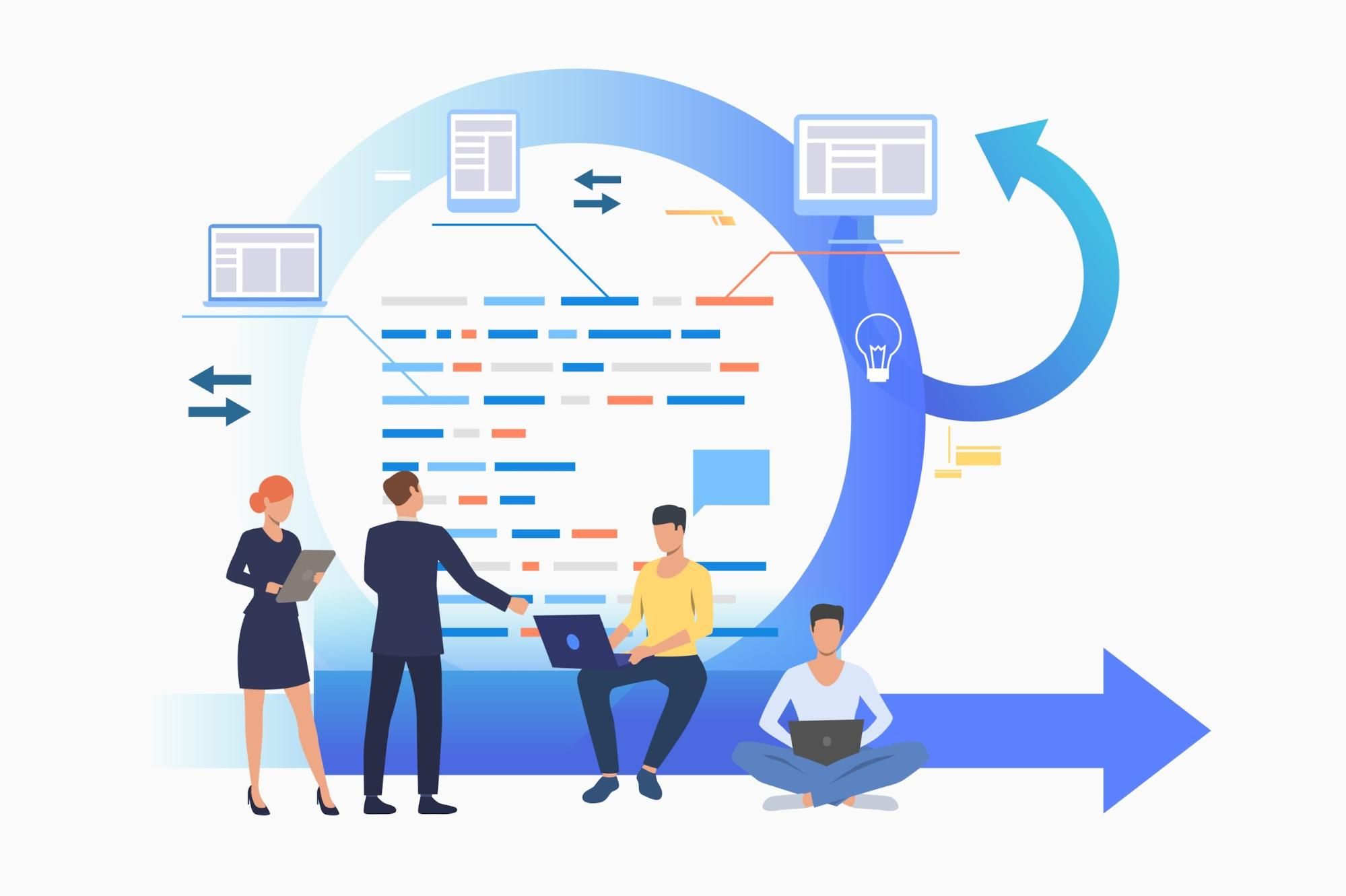
Businesses run on processes like invoicing, payroll, and support. When these steps stay manual, they slow everything down and create errors.
Companies that run line-of-business operations are already looking for ways to handle their business processes faster. The easiest way is to apply workflow automation.
With digital workflow automation, those tasks move on their own once a trigger fires. That shift means fewer delays and better focus on the work that needs people.
In this guide, you'll see five ways to automate business workflows in 2026.
Discover how much time you can save when you try Activepieces for free!
TL;DR
- You can automate business workflows using triggers, actions, and rules.
- The main benefits include improved efficiency and streamlined operations, since you spend less time on manual steps and follow-ups.
- The five best ways to automate business processes are: automating repetitive tasks, with AI agents for custom workflows, integrating business apps, using no-code automation, or open-source automation tools.
- Activepieces gives you one place to build and run these workflows using no-code tools, AI agents, and pre-built integrations.
What Does It Mean to Automate Business Workflows?
A workflow, or workflow process, is a chain of steps that finishes a piece of work. Each task follows the one before it, and together they form a system that repeats the same way every time.
When you use workflow automation, software runs the steps for you under predefined rules. That means fewer delays, fewer errors, and more space for people to handle work that actually needs judgment.
Automation runs on three parts:
- A trigger starts the flow, such as a new lead in a form
- Actions follow, like sending a message or updating a database
- Conditional logic decides which way the process moves
The use cases cover every corner of business.
For instance, human resources can handle the onboarding process from documents to account setup. Finance can route invoices and speed up recurring tasks like payroll. IT can push tickets to the right person, while project management tasks can trigger updates and reminders.
Over time, these automated workflows turn slow steps into reliable systems that streamline operations.
Key Benefits of Workflow Automation for Businesses
Automating routine tasks reduces the need for manual labor and frees staff for higher-value work. A system that runs on predefined rules keeps projects moving without delay and trims the hours lost on small actions.
An automated process handles specific tasks automatically, like logging calls or updating records, at a pace no human can match. That shift helps reduce human errors tied to manual data entry and makes results more consistent. These checks improve efficiency and support compliance and reporting.
As you put less manual effort, it translates into long-term cost savings and better resource allocation. Managers know where time goes and can adjust accordingly.
And better records lead to stronger decisions about staffing and budgets.
On the customer side, automation speeds up responses, which raises customer satisfaction. Clean customer data means teams can personalize messages and keep service smooth.
Altogether, these gains help streamline task management, boost productivity, and support growth that doesn't depend on adding headcount.
5 Ways to Automate Business Processes in 2026
Companies have different business needs, but the goal is often the same: cut delays, lower mistakes, and scale without extra staff.
When you implement automation, common steps run faster and with less effort. These changes maximize efficiency and give you time for more valuable work.
1. Automate Repetitive Tasks
Administrative work takes up a large part of business process management. Many of these manual tasks follow steps, which makes them perfect for automation.
Scheduling and Calendar Management
Coordinating meetings often eats up more time than the meeting itself. Automated workflow systems let people view your availability and book directly.
Some even suggest optimal times based on everyone's calendars. Once the slot is confirmed, reminders go out and follow-ups land automatically.
How Activepieces Helps
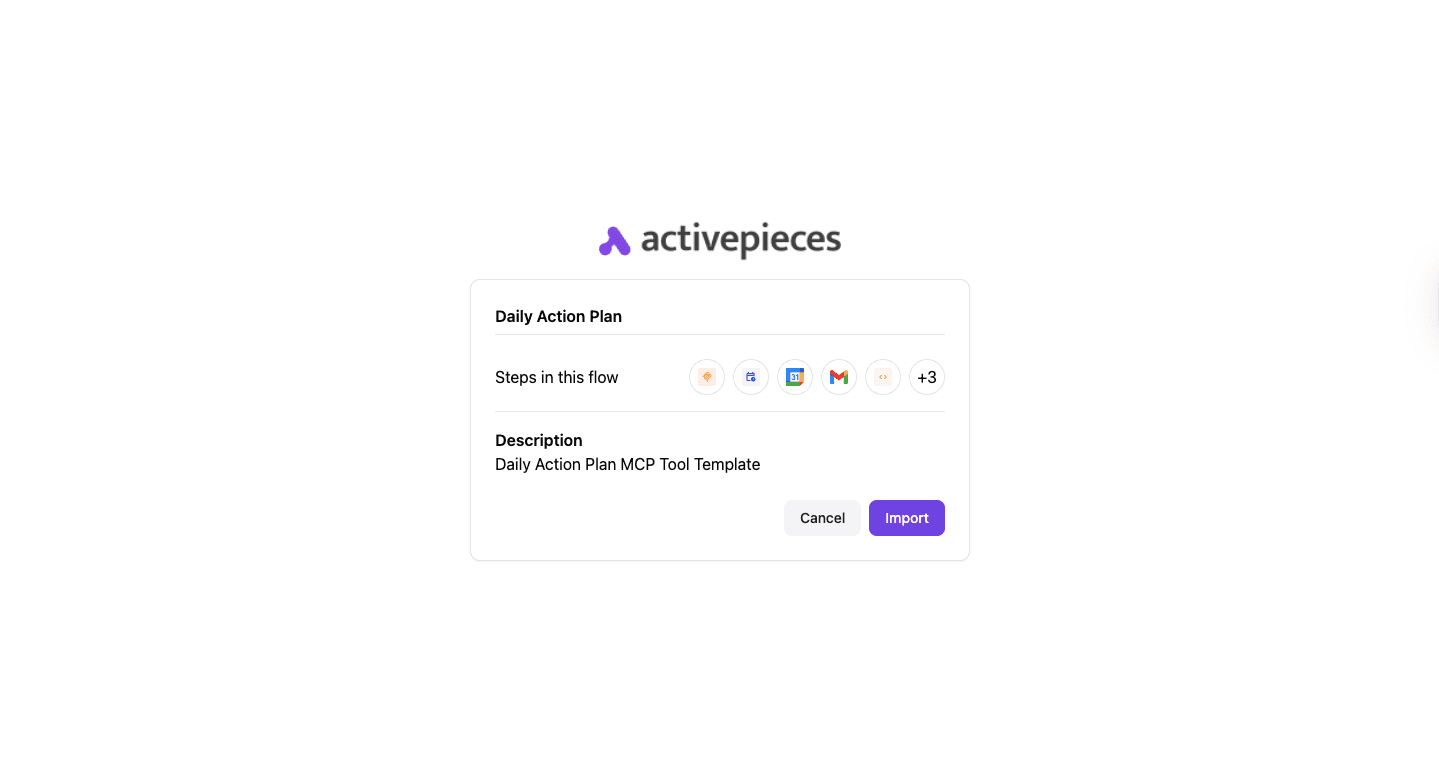
Activepieces offers a "Daily Action Plan" automation that connects to your calendar and inbox. It scans events and emails from the last 24 hours and creates a clear agenda for the day.
You'll get a list of meetings, priority messages, and a proposed plan, all without lifting a finger.
Get the template here: Daily Action Plan
Expense and Invoice Processing
Processing invoices usually requires approvals, checks, and updates. Automated systems can read invoice details, push them into finance systems, and assign them to the appropriate team members for review.
How Activepieces Helps
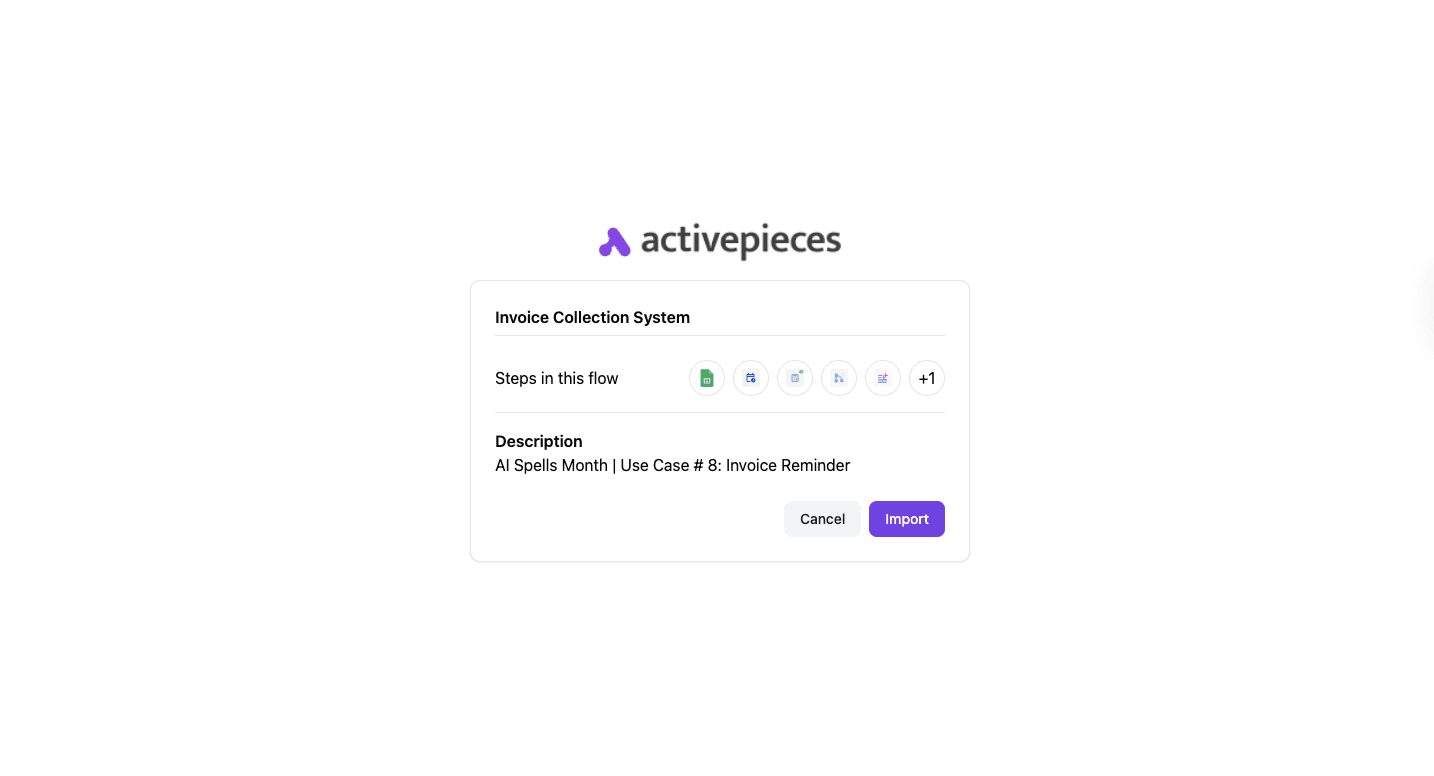
The "Invoice Reminder" flow in Activepieces tracks overdue payments. It connects to platforms like Stripe, calculates overdue days, and sends firm but polite reminders through email.
Freelancers, agencies, and business owners can maintain cash flow without chasing clients manually.
Get the template here: Invoice Reminder
Human Resources Tasks
HR teams manage multi-step processes like payroll and the onboarding process. Automation can prepare documents, set up accounts, and route requests without delay. It also logs updates for compliance.
How Activepieces Helps
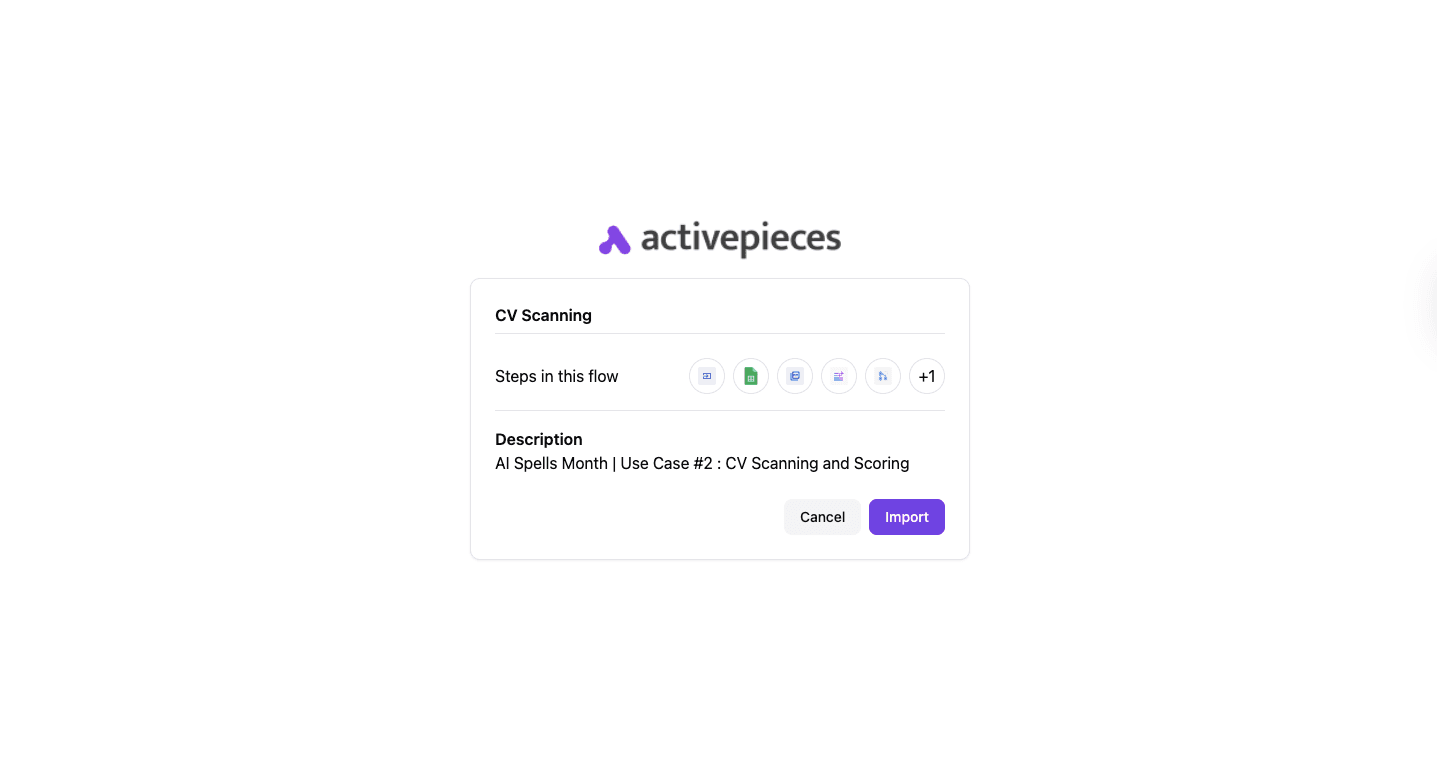
With "CV Scanning and Scoring," Activepieces processes candidate resumes using AI. It summarizes each CV, scores it against a job description, and logs the results in Google Sheets.
Qualified candidates get sorted into the right folder automatically, which cuts screening time dramatically.
Get the template here: CV Scanning and Scoring
Communication and Document Management
Standard forms, contracts, and routine emails can be prepared with templates and rules. Incoming requests can be routed to the right inbox, while finished documents are stored automatically.
How Activepieces Helps

Flows in Activepieces can auto-generate documents, route approvals, and even draft replies with AI.
Sales teams can use automations like "Demo Call-Scoring" and "Automatic Scraping of Company Information Before Calls" to prepare summaries, capture insights, and tailor conversations before the meeting even starts.
Get the template here: Demo Call-Scoring
2. Use AI Agents to Handle Custom Workflows
Traditional automation follows rules you set in advance. AI agents go further by adjusting to new inputs, learn from past outcomes, and working together across tools. That makes them useful when a process needs judgment or when outcomes depend on changing data.
By adding agents, you can create automated triggers that start flows without manual intervention. The result? Faster actions, fewer delays, and more efficient workflows.
Agents operate in a cycle of perception, planning, action, and learning. First, they read inputs such as emails, tickets, or live data. They then reason through those inputs, break larger goals into smaller parts, and generate a plan.
From there, these AI agents carry out actions across systems: sending updates, writing records, or routing work.
After execution, they measure results and improve for next time. That loop makes agents reliable for timely responses in support, sales, and operations.
How to Create a Customer Service Agent With Activepieces
Activepieces includes a template that turns ChatGPT into an SMS support agent. To set it up, you'll need an Activepieces account, a Twilio number, and an OpenAI API key.
Then do the following:
- Copy the SMS ChatGPT customer service template inside Activepieces
- Link your Twilio account so new texts trigger the flow
- Connect OpenAI and add details about your business so the model responds in context
- Set up the SMS action, so replies are sent back through Twilio
- Publish the flow and test by sending a message to your Twilio number
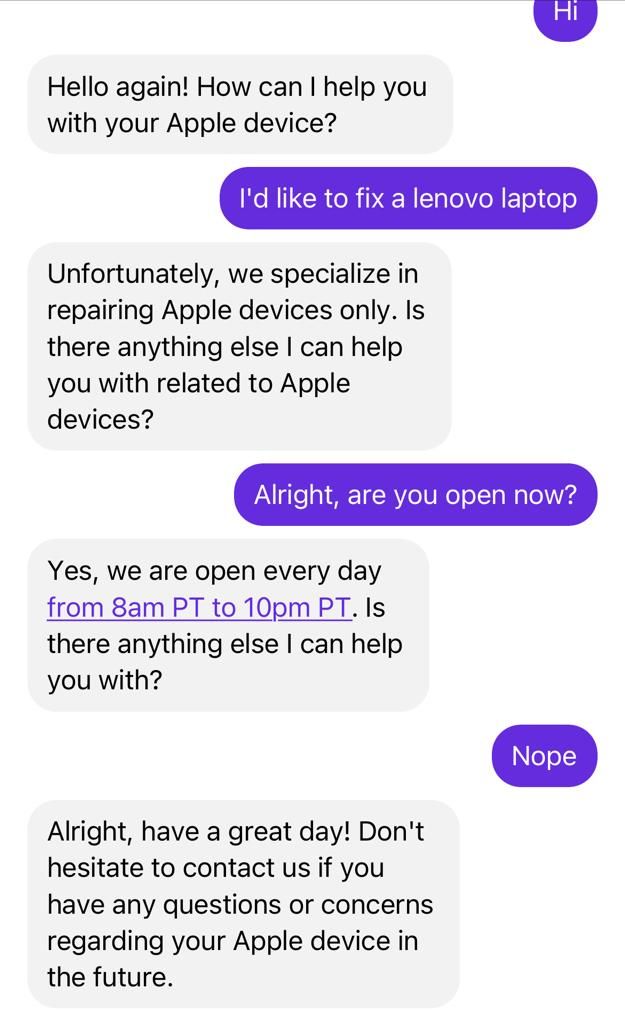
The "SMS ChatGPT Customer Service Agent" reads each customer's text, stores conversation history, and replies with context. It runs on your rules but adapts with AI.
That means faster replies, lower support load, and a better experience for your customers.
Set up an SMS customer service agent in minutes. Do it with Activepieces!
3. Integrate Business Apps
When apps run in silos, work slows down. Teams jump between platforms, copy data, and repeat steps. By connecting tools, you remove those gaps and build flows that enable instant data transfer.
Modern platforms let apps exchange data through APIs, webhooks, and middleware. This kind of integration with existing systems makes automation practical without a full rebuild. It also gives you seamless integration across apps and lets you extend automation into other systems your team already depends on.
APIs remain the backbone for most app-to-app communication. A form submission, for example, can use an API to add a new record in a CRM. Middleware and iPaaS platforms manage more complex setups by centralizing connections, while webhooks trigger events in real time.
Businesses can choose point-to-point connections for simple needs, hub-and-spoke for broader coverage, or service bus models for large internal networks. Whatever the model, data integrations cut mundane tasks and create reliable paths for data.
Activepieces Integrations
Activepieces makes app connections simple with its "pieces," a library of pre-built connectors. These pieces handle the heavy lifting, so you don't need custom code for every connection.
You start by picking a trigger, like a new row in Google Sheets. Then you add actions, such as creating a contact in HubSpot and sending an alert to Slack.
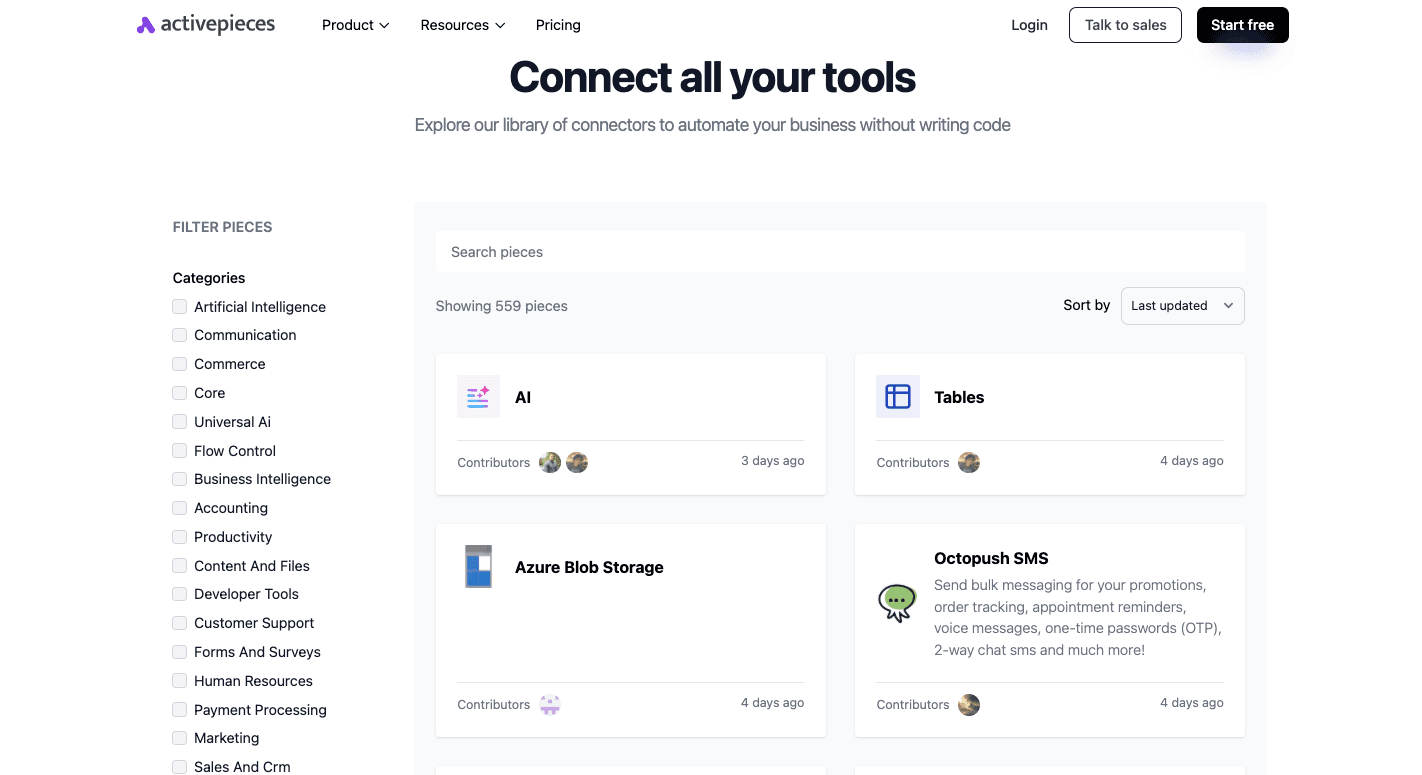
As of now, there are 559 pre-built connectors available. Some of them include:
- ClickUp
- OpenAI
- Gemini
- ElevenLabs
- Google Sheets
- Microsoft Excel 365
- Zoho CRM
- WooCommerce
- HubSpot
Besides that, Activepieces supports custom pieces through TypeScript and advanced API management.
For non-technical users, the no-code builder offers a clear path to set up flows. Data mapping lets you pass information across steps, and AI agents can reason through inputs to handle more complex cases, like drafting replies or analyzing messages.
Put your apps to work together without extra setup. Start with Activepieces!
4. Empower Teams With No-Code Automation
Not everyone in your team knows how to code, but they still deal with repetitive work. No-code automation gives them tools that feel as simple as dragging blocks on a screen.
At the center of no-code tools is the "if-this-then-that" pattern: a trigger starts the flow, like a form submission or a new email; an action follows, such as adding the contact to a CRM or sending a message to Slack.
With conditional logic, flows can adapt to different inputs.
For example, one branch might handle support tickets marked urgent, while another routes routine requests. Pre-built templates make setup even faster, covering common cases like lead nurturing or the onboarding process.
5. Future-Proof With Open-Source Workflow Automation Software
Proprietary tools often lock you into one vendor's pricing and hosting model. That setup works in the short term but limits flexibility over time.
Open source AI workflow automation avoids those limits. You own the code, choose how and where it runs, and adapt it to fit your team's needs.
With open source, you can deploy on your servers, in a private cloud, or in a hybrid setup - you're not stuck with one provider. The open model also means updates and bug fixes arrive quickly because they come from a global community.
Open-source platforms further lead to long-term cost savings. You skip expensive licenses and scale without paying extra each time you expand. Paid support or premium features are optional, not mandatory.
Why Many Businesses Use Activepieces as Their Workflow Automation Tool

Activepieces, a workflow automation solution, is for small businesses that need simple flows and for enterprises building complex workflows across multiple departments.
The user-friendly interface makes it easy for anyone to create workflow automations, while developers can dive deeper with custom pieces built in TypeScript.
Features included:
- Visual builder - Drag-and-drop flows that allow non-technical users to build new automated workflows in minutes.
- Pieces library - Hundreds of pre-built connectors with community-driven growth that often outpace other systems.
- AI-ready - Native AI steps and agents that can summarize, analyze, and draft content inside flows.
- Human-in-the-loop - Add approvals or timed delays to keep workflow execution safe where oversight is needed.
- Security - Self-hosting with robust security measures and detailed access controls for sensitive data.
- Scalability - Ability to automatically scale multiple workflows that handle everything from routine steps to advanced, multi-step processes.
Contact sales today to see why thousands of teams trust Activepieces!
Automate Smarter and Faster in 2026 With Activepieces
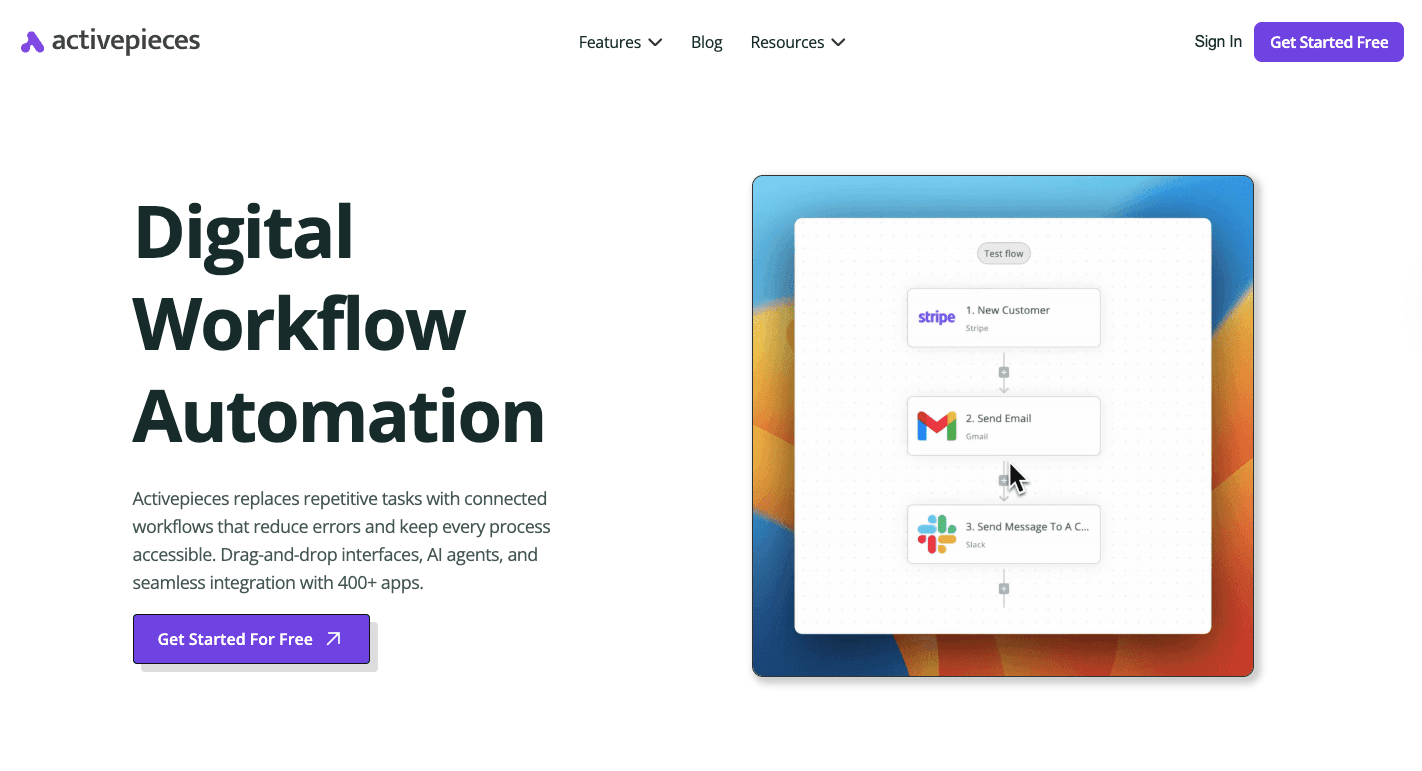
With Activepieces, you don't need coding skills to get started. The builder lets you drag steps into place, set triggers, and watch flows run.
For teams with developers, the platform still leaves room to add custom pieces and extend what's already there.
Right now, there are 559 pre-built connectors you can use, from spreadsheets and CRMs to chat platforms and payment systems. Other than that, you can run it in the cloud or keep it self-hosted if you want full control of your data.
As the community grows, more connectors get added, so you don't end up waiting months for integrations to catch up.
For teams in 2026 looking to cut manual work and keep processes moving, Activepieces gives an easier way to build digital workflows that handle repetitive tasks in your business.
You can try it for free, then it costs $5 per active flow per month, with unlimited runs and access to AI agents.
Build your first automation in minutes and see it run. Try Activepieces for free!
FAQs About Automating Business Workflows
What is the difference between workflow automation and RPA?
Workflow automation connects apps and systems so tasks move based on predefined criteria, while robotic process automation focuses on mimicking human actions inside software.
Workflow automation is usually workflow-based, managing end-to-end processes, while RPA handles smaller manual processes like copy-paste actions. Both aim to minimize mistakes, save time, and improve business outcomes.
How do AI agents fit into business process automation?
AI agents analyze text, numbers, or tickets, break down time-consuming tasks, and make choices where rules alone aren't enough. An agent analyzes data, involves stakeholders, and even drafts customer replies, which improves customer experience and keeps service quality high.
Is workflow automation expensive?
Costs vary, but many platforms offer free tiers or predictable pricing. Open-source options lower expenses further. When applied to the right processes, automation pays for itself by reducing manual processes, helping teams streamline workflows, and boosting long-term efficiency.
What tools are best for automating workflows?
Activepieces stands out as an open-source, AI-ready tool that balances no-code simplicity with enterprise features. It supports advanced flows, scales well, and avoids the billing issues tied to task-based competitors. Its design makes automating tasks easier for any team.
What are the common mistakes to avoid when implementing workflow automation?
Rushing to automate broken steps, skipping user feedback, or neglecting data quality leads to poor results. Over-automation also harms flexibility. To avoid failure, set clear goals, use performance metrics, and track metrics that matter most. Regular reviews keep workflows reliable and aligned with business needs.


